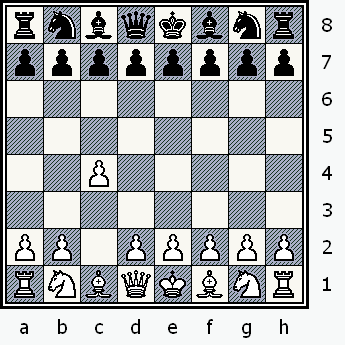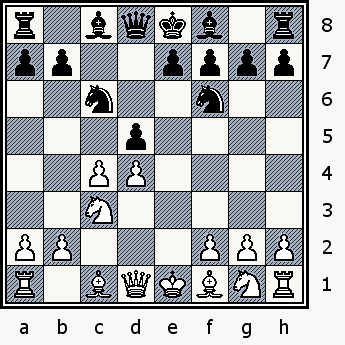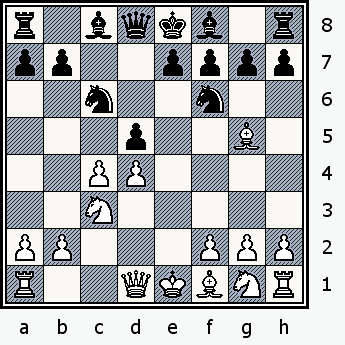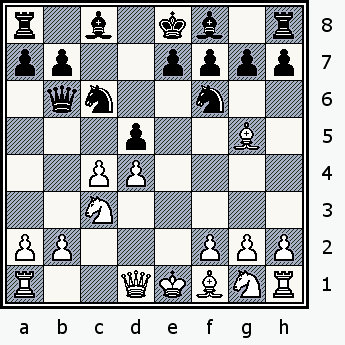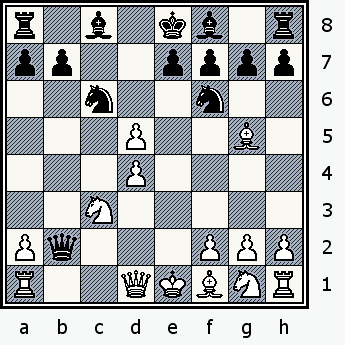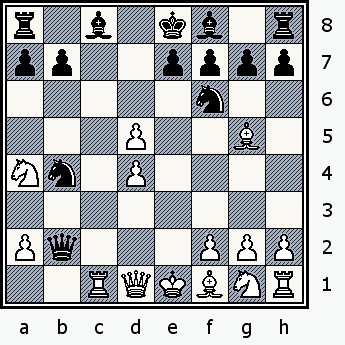All
the |
(Navigation bar
directly below.)
*******
© A.J. Goldsby, 2015.
(All rights reserved.)
****************
Click HERE
to see my
Chess Items.
****************
****************
Buy a book
from Amazon.com
(And help me out as well!)
****************
Click HERE
...
to see a list of the businesses that help to sponsor all of
my chess efforts.
|
|
A great, short game of chess! |
|
|
A
great little game of chess. A fantastic, short game of chess. This game is also a trap ... that numbers many strong players among its victims! ******************************************************************************* This is primarily a text page - with just a few diagrams. You will probably need - and will want to use - a regular chess board. Click HERE to see an in-depth and complete explanation of all the symbols that I use when annotating a chess game. |
GM M. Botvinnik (2635) -
GM R. Spielmann (2605)
|
|
|
*********************
Contrary to what is given in many books and databases, the game began with the move, 1.c2-c4.
[ Also good is:
1.e4, {Diag?}
which is the move order that
we are normally accustomed
to seeing a Caro-Kann Defense
begin with. (I.e., 1.e4, c6; 2.d4, d5; etc.)
]
1...c6!?;
2.e4!? d5; ('!')
Black is not easily deterred from
making his all-important break
in the center.
3.exd5 cxd5;
4.d4!,
Play has transposed into a
normal Caro-Kann Opening.
This line today is known as: "The Panov-Botvinnik Attack,"
versus the Caro-Kann ...
one
of the better ways {for White}
to meet this particular opening.
[ Interesting is: 4.cxd5!?, {D?} with a playable position for both parties from here. ]
4...Nf6!;
5.Nc3 Nc6!?; {See the diagram - just
below.}
A slightly unusual - but not bad -
way of meeting White's method for
handling this opening.
(Black tries
to avoid closing in his QB with
the pawn move of .e7-e6.)
*********************
|
|
*********************
Blacks' method of development here also emphasizes piece play over other <positional> factors.
Black could also play ...dxc4; in this
position, with play similar/transposing
to a Queen's Gambit Accepted.
(See the game:
V. Ragozin - Vitaly Chekover; {# 7.}
Round One / Moscow, RUS; 1935.)
[ The most common line today
begins with the move: 5...e6;
{Diagram?}
[ See MCO-14, page # 183;
beginning with column # 37.]
****************************************************
Black has also played:
5...g6!?;
{Diagram?} with massive complications.
{See any good opening book.}
See also the game: Bogatyrchuk - Levenfish; (# 125) from the same tournament. ]
6.Bg5!,
"/\"
{See the diagram - just below.}
The sharpest and most energetic
response by White, but one that
had been called into question by
several analysts of that period.
(Mistake # 2 - as concerns this
particular game.)
*********************
|
|
*********************
"A difficult move to meet, Black's safest reply here is 6...P-K3." - Irving Chernev.
[ Also perfectly acceptable is
the move Nf3, in this position.
[See MCO-14, page # 181,
columns # 34-35, and all notes.]
*****
This is a variation that I personally have used many times.
For example:
6.Nf3 Bg4; 7.cxd5! Nxd5;
8.Qb3!! Bxf3!?; 9.gxf3 Ndb4!?;
10.d5!? Nd4; 11.Bb5+!? Nxb5;
12.Nxb5 Nxd5?; 13.Qxd5!,
"+/-" {D?}
Black Resigns, 1-0. (After the
capture on d5, Black will regain
the Queen
with a Knight fork on
the c7-square, remaining a
piece ahead.)
A.J. Goldsby I - David Jacobs;
The Southern Open, Round # 01
/
Altamonte Springs, FL; 07,2000. ]
6...Qb6?!;
(hmmm) {See
the diagram ... just below here.}
This is ... NOT at all the horrible
move some authors have made it
out to be!!! {Mistake # 03.}
It is
DEFINITELY NOT the losing move!
Some - very current - books give
this move an exclam ... but I do not
think that they are correct.
(Suetin only gives: "6...Qd8-b6!?")
In the book of the tournament, they give this move a whole question mark ('?') here. Mikhail Botvinnik - annotating this game in a Soviet magazine - referred to this move as ... "the fatal error." This is also very wrong - completely incorrect.
My take on this move is that it
brings out the Queen too early ...
and allows Black's center to crumble.
When you {also} consider the fact
that Black has several playable and
clearly superior alternatives, then I
think that "dubious" is the correct
evaluation of this move. (Fritz 8.0
also notices a fairly sizeable down-turn in its scores of the position
after this move.)
Another point - that is regularly overlooked as concerns this game - is that this move of ...Q/d8-b6; was 'book' at the time of this game. And that it was highly recommended by several Czech masters in a very prominent article, in a leading chess magazine ... of that particular period!
*********************
|
|
*********************
This is a good place for a diagram.
[ Much more solid ... and preferable was the following continuation:
(>/=) 6...e6!?;
7.Nf3 Be7;
"~" {Diagram?}
(and) Black's position is very good.
[ See MCO-14, page # 181;
column # 33, and all notes. ]
The opening books tend to grant
White a VERY significant edge in
these variations ...
however, the
overall results in the database
do NOT back this up! (In fact,
Black won
ALL!! the {decisive}
games that I could find in the
database - that fit the following
important criteria:
# 1.) Played in the last 30 years.
# 2.) A minimum FIDE rating for
both players of at least 2400.)
IM Darius Zagorskis (2515) -
GM Daniel Fridman; (2520);
ICT / VL 9798 playoff /
Ruhrgebiet, GER; 1998.
{Black won this game.};
***************************************************************************
The best line - according to modern theory - might be:
>/= 6...Qa5!;
7.Bxf6!?,
{Diagram?}
This is interesting here.
( MCO gives 7.Bd2!?, here.
[ See page # 181, column # 32,
and all notes.] )
7...exf6!; 8.cxd5 Bb4!;
9.Qd2 Bxc3; 10.bxc3 Qxd5; 11.Nf3!,
{Diagram?}
This is probably the best here.
( Or White could play: (</=) 11.Ne2!? 0-0; 12.Nf4 Qd6;
13.Be2 Bf5; "~" (Probably "=") {Diagram?}
Ornstein - GM L. Shamkovich; ICT/Masters/Gausdal/1984. )
11...Bg4!?;
{Diagram?}
This is OK, I guess; but ...
*** *** *** *** *** *** *** *** *** *** *** *** *** *** *** *** *** *** *** ***
( Maybe a little better was: 11...0-0; "=" {Diagram?}
with a seemingly solid position
for the second player here.
P. van der Sterren - J. Nikolac; Eerbeek, NED; 1978.
[ See MCO-14, page # 181; column # 35, and note # (e.). ] )
*** *** *** *** *** *** *** *** *** *** *** *** *** *** *** *** *** *** *** ***
12.Be2 0-0; 13.0-0,
According to an {older} analysis
by GM Issac Boleslavsky, ...
"White's chances are clearly
preferable in this position."
(Hiarcs likes Black in this position,
Fritz 8.0 awards White only a few
one-hundredths of a point of any
advantage here.)
The overall results from the
database is a mixed bad for this
line.
(No one side has a clear
edge in the overall results - from
the current position.)
H. Ruwette,H - J. von Gelderen;
Corr. / NED BV-95-15, 1996.
(White won a very convincing
game ...
but perhaps Black play
could be improved somewhere.);
**************************************************************************
Another respected reference
work gives the continuation:
6...Be6!?; 7.a3! Qd7!;
8.b4!? dxc4; 9.Bxf6 gxf6!?; 10.d5 0-0-0;
11.Bxc4 Ne5; 12.Bb5 Qc7;
The end of the column.
13.Nge2, "+/="
{Diagram?}
White has a slight edge.
GM Zigurds Lanka
(2500) -
GM Utut Adianto (2495);
ICT / Master's Open /
Adelaide, AUS; 1990. {1-0 in 47 wild moves.}
[ See MCO-14; page # 181; column # 31, & also note # (d.). ] ]
(After a detour into opening
theory, we return to the actual
game at hand.)
7.cxd5!,
"/\"
This move represented both
a TN ... and a significant
improvement over previous
play.
[ Worse was:
</= 7.c5? Qxb2!; "/+"
{Diagram?}
{When Black is clearly better.}
Spielmann-Rejfir; Maribor, 1934.
NOTE - who is White and who is Black in this game.
Apparently
after getting beaten in this line,
Spielmann analyzed it in depth ...
and decided to use it himself! ]
7...Qxb2?;
{See the diagram - - - just below.}
This is a really bad move, and is
harshly condemned by modern
chess opening theory.
(Chernev
also awards it a question mark.)
*********************
|
|
*********************
Mistake # 04: Most people tend to
overlook that this is the losing move
for Black - NOT 6...Qb6.
(Most
good computer programs tend to
note a VERY large and dramatic
shift in their 'scores'
for this position.)
"Pawn-grabbing with the Queen, at the expense of development, is always perilous." - I. Chernev
[
MUCH better was the following
continuation for Black:
>/= 7...Nxd4;
('!') {Diagram?}
which is a huge improvement
over the way that the Botvinnik-Spielmann game was played.
Now theory gives three main paths
for White - according to Suetin.
(Nf3, Be3, and Nge2.)
I continue with the move that
Deep Junior picks ... after more
than 45 minutes of machine time.
8.Be3! e5[]; 9.dxe6 Bc5; 10.exf7+ Ke7!;
11.Bc4 Rd8; 12.Nf3!? Bg4; 13.Bxd4 Rxd4;
14.Qe2+ Kf8; 15.Bb3!,
"+/=" {Diagram?}
White has a solid edge in this
position. (Additionally, Bxd4 on
move 12 - for White - might
represent a fairly significant
improvement in this line.)
If now 15...Rf4; then simply 16.0-0-0, will yield White a very substantial advantage.
Now Suetin gives the following
continuation from this position:
15...a7-a5!?; 16.0-0, a5-a4;
17.Bb3-d1!, "+/="
etc.
Rothgen - Gelenczei;
Correspondence Game, 1967.
(Line # 2, Page # 101 of the
GM Alexei Suetin book on the
Caro-Kann Defense.);
**************************************************************************
**************************************************************************
I had a postal game - about 10
or 15 years ago - that went
something like:
(</=) 7...Nxd5?!; 8.Nxd5 Qa5+;
9.Nc3 Qxg5; 10.Nf3 Qf5!?;
11.d5! Ne5; 12.Bb5+ Bd7;
13.Bxd7+ Nxd7; 14.0-0,
"+/=" ('±') {Diag?}
and I had a very significant edge
here as White ... I don't think my
opponent
lasted beyond move 40. ]
White's next move may merit
TWO exclamation points ... for
various factors that are explained
below.
8.Rc1!,
(Very nice.)
"It is only in this quiet move that
White finds the refutation of his
opponent's conception in this
game." - GM Mikhail Botvinnik. {Writing for a USSR chess
magazine ... of that period.}
This move was a shock. His
tricky adversary had not counted
on this move, that apparently
Botvinnik
discovered ...
WHILE AT THE CHESS-BOARD!!
(The fact that this was all a ...
prepared variation {by Black}, and that
Botvinnik had refuted this at the
board constitutes
Mistake # 05; as concerns this famous game.)
[ Apparently Spielmann had looked
at all of this - quite extensively -
BEFORE the game!
He had even
prepared the following variation
for his esteemed opponent: (</=)
8.Na4!? Qb4+; 9.Bd2 Qxd4; 10.dxc6
Ne4!; "~" {Diagram?}
and Black has serious play
in this position.
(E.g., 11.Be3, Qb4+; 12.Ke2, bxc6!; "=/+" and Black has threats.)
]
8...Nb4!?;
It does not matter what Black plays
in this position - his game is beyond
all hope of salvation.
The tournament book says that: "Black could have held on longer with ...Nd8."
[ Probably better was:
>/= 8...Nd8;
{Diagram?}
for Black in this position.
However White would still win
with the following continuation:
9.Bxf6! exf6; 10.Bb5+! Bd7;
11.Bxd7+ Kxd7; 12.Qg4+!,
{D?}
and the first player has a really
powerful attack, ("--->"); that
should
eventually win ("+/-")
the game for White. ]
The rest really needs no
commentary at all.
9.Na4!,
{See the diagram - just below here.}
*********************
|
|
*********************
9...Qxa2!?;
10.Bc4 Bg4!?; 11.Nf3! Bxf3; 12.gxf3, ("+/-")
His position is hopeless ...
so ... BLACK RESIGNS.
<< If 12...Qa3; then White simply
plays 13.Rc3. Then - in order to
save his Queen, - Black
must play 13...Nc2+; and give up a Knight;
after which his game is, of course,
hopeless. >>
(The book of the tournament.)
*********************************************************************
*********************************************************************
An extraordinary short game ... that is unfortunately often simply relegated to a trap book, and given with almost no proper commentary at all. {There are some good stories behind this game, its just not a simple trap!}
Additionally, you cannot begin to really understand this game until you seen it with the very extensive notes that are given to it -- in the very exceptional book of this great tournament!!!
*************************************************************************
*************************************************************************
BIBLIOGRAPHY
I have seen this game many times print, but the following two sources were the most useful in preparing my annotations of this game:
# 1.)
"Winning
Chess Traps," by the incomparable
Irving Chernev.
Copyright by the author, published
by 'Chess Review' (NY) in 1946.
(Re-printed in 1951, 1956, 1959,
1967, 1970, 1972, 1973, and also
in May 1974.
This book has probably
been reprinted many times since
then as well.)
ISBN: # 0-679-14037-9
*************************************************************************
# 2.)
{The book of the tournament.}
"The
Second International Chess
Tournament / Moscow, 1935."
(Dozens of players and analysts
contributed to the original book.
Some of the notables were:
Alortsev, Botvinnik, Levenfish,
Belyavnets, Bogatyrchuk,
I. Kan,
Lillienthal, Lisitisin, Ragozin,
Romanovsky, Sozin, V. Chekover,
M. Yudovich
and even Max Euwe.
N. Krylenko and I. Rabonovich
were the editors for this really
massive project.)
*** *** *** *** *** *** *** *** *** *** *** *** *** *** *** *** *** *** *** *** ***
The {original} book was published in Moscow shortly after the tourney. (1936 or 1937?)
My {current} edition is in English. (Translated by Jimmy Adams and also S. Hurst.)
Copyright (c) 1998 - Caissa Editions, a division
of Dale A. Brandeth books.
(Yorklyn, Delaware; USA.) ISBN: # 0-939433-52-4
*******************************************************************************
I also looked at nearly all of the books in my library that cover this particular opening. This includes all the 'alphabet-soup' ones like: SCO, BCO, ECO, MCO, etc.
I also looked at or consulted a
dozen (or more) books and
pamphlets on the Caro-Kann
Defense.
Probably one of the
best was the book:
# 3.)
"The
Caro-Kann Defence," by
GM Alexei Suetin. Copyright (c) 1983.
Updated and translated in 1988.
Printed by 'Sportsverlag' {GER}
for Batsford Books. (London, ENG.)
ISBN: # 0-7134-5939-5
(All games - HTML code initially) Generated with ChessBase 8.0
All the diagrams on this page were created with the program, Chess Captor 2.25.
Copyright (©) A.J. Goldsby, 2004. All rights reserved.
1 - 0
|
If you enjoyed
this analysis, (or want to comment on it); and would like to contact me
... this is my contact information: The way this game is presented here is pretty much the way that I developed it in my ChessBase files. I modified it slightly for the sake of appearance. It is as complete as I can make it. I started on this project many times ... but never finished it. (I had just started to annotate this game last April or May ... and then my whole system had to be replaced. Just another day in the life of a webmaster.) Click HERE to go (or return) to my HOME PAGE, (for this site). Click HERE to go (or return) to my page on ... "The BEST Players." Click HERE to go (or return) to my Annotated Games Page, (for this site). Click HERE
to go (or return) to my PAGE
... Click HERE to go (or return) to my page for Chess Traps. (Or use the 'BACK' button on your web browser.) ***************************************************** Copyright (c) A.J. Goldsby I
Copyright (©) A.J. Goldsby, 1985 - 2010. ***************************************************** Page first created in August, 2004. First posted on the 'net: Tuesday; September 03rd, 2004. This page was last updated on 07/14/12 . |
